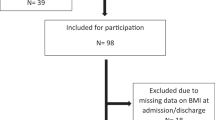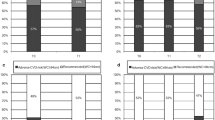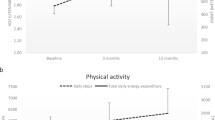Abstract
Study design
Controlled pragmatic intervention with follow-up.
Objectives
To describe cardiometabolic risk outcomes after a pragmatic intervention implemented into standard spinal cord injury (SCI) rehabilitation.
Setting
Inpatient SCI rehabilitation in East-Denmark.
Participants
Inpatients, >18 years, having sustained a SCI within the last 12 months at admission to rehabilitation, regardless of etiology, neurological level or completeness of the lesion or mobility status.
Methods
Patient education on health promotion was guided by evidence and included feedback on peak oxygen uptake (VO2peak) (primary outcome measure), body mass index (BMI), Dual energy X-ray absorptiometry and metabolic profile (secondary outcome measures). Paired t-tests, non-parametric tests and Analysis of Variance (ANOVA) were used for analyzes. VO2peak and BMI were compared to historical data.
Results
VO2peak increased significantly from admission to discharge but did not exceed historical data despite a minimal clinical important difference. BMI decreased significantly during rehabilitation (p < 0.001) followed by a significant increase after discharge (p = 0.006). There was a trend that people with American Spinal Injury Association Impairment Scale (AIS) D SCI increased lean mass to nearly normal values. Criteria for pre-diabetes or diabetes were present in 28.5% and dyslipidemia in 45% of the participants 44.2 days after time of injury.
Conclusions
Despite improvements during rehabilitation, outcome measures were worse than recommended, and most outcome measures worsened at follow up, even in people with an AIS D SCI. Meaningful support regarding exercise and diet when tackling altered life circumstances is needed after discharge.
This is a preview of subscription content, access via your institution
Access options
Subscribe to this journal
Receive 12 print issues and online access
$259.00 per year
only $21.58 per issue
Buy this article
- Purchase on Springer Link
- Instant access to full article PDF
Prices may be subject to local taxes which are calculated during checkout


Similar content being viewed by others
Data availability
The datasets generated and analyzed in the current study are available upon reasonable request to the corresponding author.
References
Farkas GJ, Gater DR. Neurogenic obesity and systemic inflammation following spinal cord injury: A review. J Spinal Cord Med. 2018;41:378–87.
van der Scheer JW, Martin Ginis KA, Ditor DS, Goosey-Tolfrey VL, Hicks AL, West CR, et al. Effects of exercise on fitness and health of adults with spinal cord injury: A systematic review. Neurology. 2017;89:736–45.
Nash MS, Groah SL, Gater DR Jr, Dyson-Hudson TA, Lieberman JA, Myers J, et al. Identification and Management of Cardiometabolic Risk after Spinal Cord Injury: Clinical Practice Guideline for Health Care Providers. Top Spinal Cord Inj Rehabilit. 2018;24:379–423.
Martin Ginis KA, Jörgensen S, Stapleton J. Exercise and sport for persons with spinal cord injury. PMR J Inj Funct Rehabilit. 2012;4:894–900.
Martin Ginis KA, van der Scheer JW, Latimer-Cheung AE, Barrow A, Bourne C, Carruthers P, et al. Evidence-based scientific exercise guidelines for adults with spinal cord injury: an update and a new guideline. Spinal Cord. 2018;56:308–21.
Nooijen CF, Stam HJ, Bergen MP, Bongers-Janssen HM, Valent L, van Langeveld S, et al. A behavioural intervention increases physical activity in people with subacute spinal cord injury: a randomised trial. J Physiother. 2016;62:35–41.
Felleiter P, Krebs J, Haeberli Y, Schmid W, Tesini S, Perret C. Post-traumatic changes in energy expenditure and body composition in patients with acute spinal cord injury. J Rehabilit Med. 2017;49:579–84.
Burkhart L, Pellegrini CA, Jones K, LaVela SL. Strategies used by providers to support individuals with spinal cord injury in weight management: a qualitative study of provider perspectives. Spinal Cord Ser Cases. 2021;7:65.
Kirshblum SC, Burns SP, Biering-Sorensen F, Donovan W, Graves DE, Jha A, et al. International standards for neurological classification of spinal cord injury (revised 2011). J Spinal Cord Med. 2011;34:535–46.
Halvorsen A, Pettersen AL. NordicSCIR Årsrapport 2019. 2019. Available from. https://stolav.no/Medisinskekvalitetsregistre/NorSCIR/%C3%85rsrapporter/NORSCIR%20%C3%A5rsrapport%202019.pdf.
Holm NJ, Møller T, Adamsen L, Dalsgaard LT, Biering-Sorensen F, Schou LH. Health promotion and cardiovascular risk reduction in people with spinal cord injury: physical activity, healthy diet and maintenance after discharge- protocol for a prospective national cohort study and a preintervention- postintervention study. BMJ Open. 2019;9:e030310.
Holm NJ, Biering-Sørensen F, Schou LH, Møller T. The test-retest reliability of individualized VO(2)peak test modalities in people with spinal cord injury undergoing rehabilitation. Spinal Cord. 2021;59:82–91.
Holm NJ, Steensgaard R, Schou LH, Møller T, Kasch H, Biering-Sørensen F. An observational study on body mass index during rehabilitation and follow-up in people with spinal cord injury in Denmark. Spinal Cord. 2022;60:157–62. https://doi.org/10.1038/s41393-021-00730-5.
Bauman WA, Biering-Sørensen F, Krassioukov A. The international spinal cord injury endocrine and metabolic function basic data set. Spinal Cord. 2011;49:1068–72.
Larsen CM, Juul-Kristensen B, Kasch H, Hartvigsen J, Frich LH, Boyle E, et al. The Danish Spinal Cord Injury Shoulder (DanSCIS) cohort: methodology and primary results. Spinal Cord. 2021;59:821–31.
Biering-Sørensen F, DeVivo MJ, Charlifue S, Chen Y, New PW, Noonan V, et al. International Spinal Cord Injury Core Data Set (version 2.0)-including standardization of reporting. Spinal Cord. 2017;55:759–64.
Suetta C, Haddock B, Alcazar J, Noerst T, Hansen OM, Ludvig H, et al. The Copenhagen Sarcopenia Study: lean mass, strength, power, and physical function in a Danish cohort aged 20-93 years. J Cachexia Sarcopenia Muscle. 2019;10:1316–29.
Wu X, Liu J, Tanadini LG, Lammertse DP, Blight AR, Kramer JL, et al. Challenges for defining minimal clinically important difference (MCID) after spinal cord injury. Spinal Cord. 2015;53:84–91.
Laughton GE, Buchholz AC, Martin Ginis KA, Goy RE. Lowering body mass index cutoffs better identifies obese persons with spinal cord injury. Spinal Cord. 2009;47:757–62.
Eriks-Hoogland I, Hilfiker R, Baumberger M, Balk S, Stucki G, Perret C. Clinical assessment of obesity in persons with spinal cord injury: validity of waist circumference, body mass index, and anthropometric index. J Spinal Cord Med. 2011;34:416–22.
Bjerre E, Brasso K, Midtgaard J. Pragmatic trials are important to medical research. Ugeskr Laege. 2015;177:V10140571.
Aspenes ST, Nilsen TI, Skaug EA, Bertheussen GF, Ellingsen Ø, Vatten L, et al. Peak oxygen uptake and cardiovascular risk factors in 4631 healthy women and men. Med Sci Sports Exerc. 2011;43:1465–73.
Simmons OL, Kressler J, Nash MS. Reference fitness values in the untrained spinal cord injury population. Arch Phys Med Rehabilit. 2014;95:2272–8.
Nooijen CF, Stam HJ, Sluis T, Valent L, Twisk J, van den Berg-Emons RJ. A behavioral intervention promoting physical activity in people with subacute spinal cord injury: secondary effects on health, social participation and quality of life. Clin Rehabilit. 2017;31:772–80.
de Groot S, Dallmeijer AJ, Post MW, Angenot EL, van den Berg-Emons RJ, van der Woude LH. Prospective analysis of lipid profiles in persons with a spinal cord injury during and 1 year after inpatient rehabilitation. Arch Phys Med Rehabilit. 2008;89:531–7.
Solinsky R, Betancourt L, Schmidt-Read M, Kupfer M, Owens M, Schwab JM, et al. Acute Spinal Cord Injury Is Associated With Prevalent Cardiometabolic Risk Factors. Arch Phys Med Rehabilit. 2022;103:696–701. https://doi.org/10.1016/j.apmr.2021.04.022.
Sundhedsstyrelsen. Danskernes sundhed- Den nationale sundhedsprofil 2017. 2018. Available from: https://www.sst.dk/-/media/Udgivelser/2018/Den-Nationale-Sundhedsprofil-2017.ashx?la=da&hash=421C482AEDC718D3B4846FC5E2B0EED2725AF517.
Lawrason SVC, Todd KR, Shaw RB, Martin Ginis KA. Physical activity among individuals with spinal cord injury who ambulate: a systematic scoping review. Spinal Cord. 2020;58:735–45.
Ma Y, de Groot S, Romviel S, Achterberg W, van Orsouw L, Janssen TWJ. Changes in body composition during and after inpatient rehabilitation in people with recent spinal cord injury. Spinal Cord Ser Cases. 2021;7:88.
Weber L, Voldsgaard NH, Holm NJ, Schou LH, Biering-Sørensen F, Møller T. Exploring the contextual transition from spinal cord injury rehabilitation to the home environment: a qualitative study. Spinal Cord. 2021;59:336–46.
Acknowledgements
The authors thank all participants and health care professionals across multidisciplinary disciplines for contributing to the study, thus reflecting the clinical setting and standard care.
Funding
This work was supported by a research program, “Centre for Integrated Rehabilitation of Cancer Patients (CIRE) - Neuro/Psychology”, conducted collaboratively by the University Hospitals Centre for Health Care Research, University Hospital Copenhagen, Rigshospitalet, University College Copenhagen, Department of Nursing and Nutrition, and the NeuroScience Centre, Rigshospitalet.
Author information
Authors and Affiliations
Contributions
NJH was primarily responsible for the study and collecting data as well as data analysis. FB-S facilitated implementation of DXA-scans and cardiometabolic profile. Together with TM and LS all authors contributed to the study design, text writing, manuscript feedback and approved the final version of the manuscript.
Corresponding author
Ethics declarations
Competing interests
The authors declare no competing interests.
Ethical approval
We certify that all applicable institutional and governmental regulations concerning the ethical use of human volunteers were followed during the course of this research. The project is approved by the Committees on Health Research Ethics in the Capital Region of Denmark on 10.07.2018 (Journal-nr.: H-18018325). All participants received oral, as well as written information about the study, before verbal and written consent was obtained. The project is registered at Clinicaltrials.gov (NCT03689023).
Additional information
Publisher’s note Springer Nature remains neutral with regard to jurisdictional claims in published maps and institutional affiliations.
Rights and permissions
Springer Nature or its licensor (e.g. a society or other partner) holds exclusive rights to this article under a publishing agreement with the author(s) or other rightsholder(s); author self-archiving of the accepted manuscript version of this article is solely governed by the terms of such publishing agreement and applicable law.
About this article
Cite this article
Holm, N.J., Møller, T., Schou, L.H. et al. Monitoring outcome measures for cardiometabolic disease during rehabilitation and follow-up in people with spinal cord injury. Spinal Cord 62, 125–132 (2024). https://doi.org/10.1038/s41393-023-00956-5
Received:
Revised:
Accepted:
Published:
Issue Date:
DOI: https://doi.org/10.1038/s41393-023-00956-5



